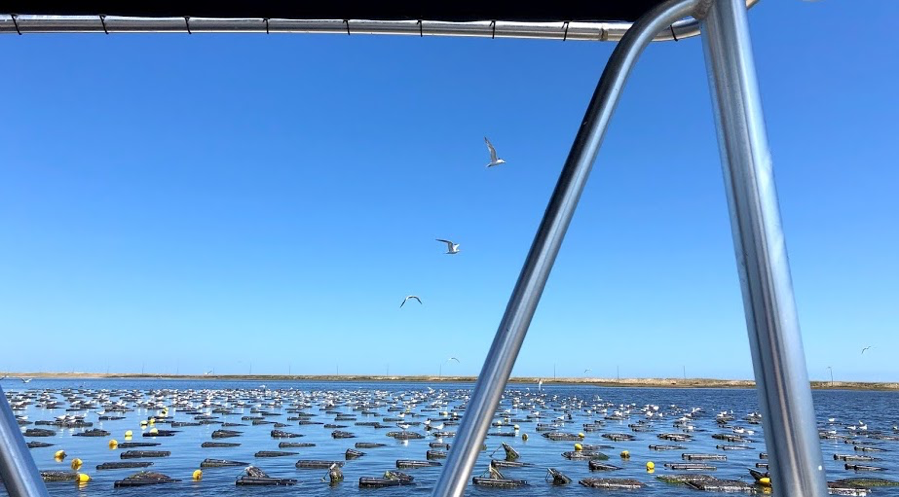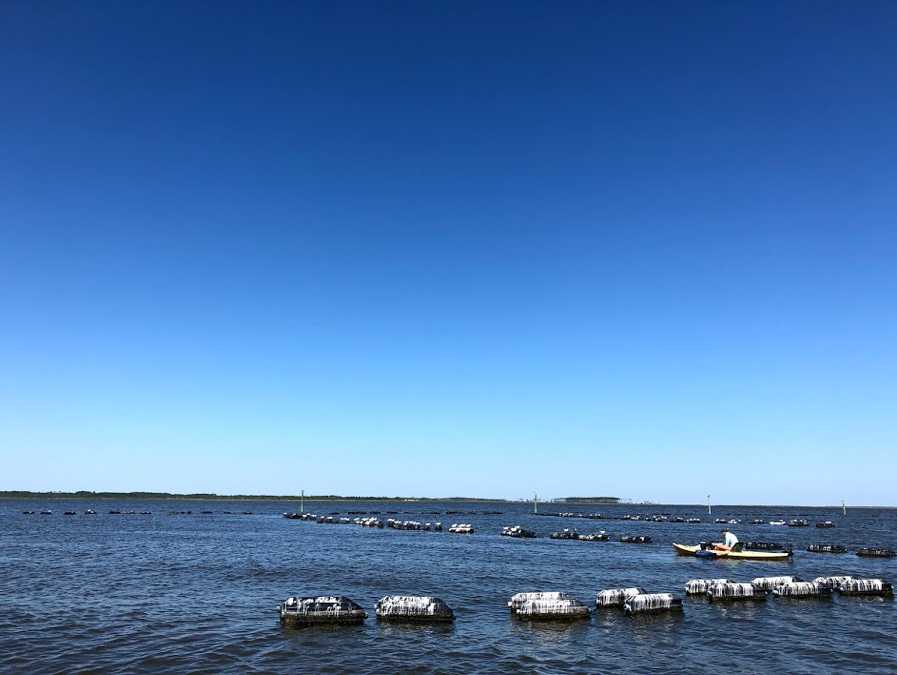
Oyster lease in Buxton, North Carolina. Photo by Marianna Miller.
BY SARAH LOFTUS
North Carolina oyster farming regulations aim to protect seagrass. Seagrass stabilizes shorelines, improves water quality, and provides habitat for economically important fish and shellfish. The state doesn’t permit oyster farms where these beneficial underwater plants cover more than 10% of the estuary bottom.
North Carolina has lagged behind other East Coast states in oyster farming, though, perhaps because such regulations limit where a farmer can purchase an oyster “lease” — a large tract in an estuary to grow oysters.
But what’s really happening at oyster leases?
Researchers at the UNC Institute of Marine Sciences (IMS) have been studying local ecosystems under oyster farms, comparing their seagrass and fish communities to areas without oyster gear. The research could provide management agencies and state government with evidence to inform whether or how to revise oyster farm leasing rules, which then could accelerate development of the state’s oyster industry.

Research technician Marianna Miller with an oyster toadfish caught in a crab pot in Hatteras. Photo by Savannah Swinea.
Supported by North Carolina Sea Grant, IMS research associate James Morley (now at East Carolina University) and his team designed experimental oyster farms to measure the effects of oyster cultivation gear like cages and floating bags on fish and seagrass.
The four-year effort took place in Hatteras Bay, where researchers could glimpse Highway 12 as they waded in waist-deep water. They measured seagrass coverage and fish communities at 15 sites, each about the size of five parking spaces. The sites had low to moderate seagrass coverage, initially 5% to 35%, to mimic sites that hypothetically could be leased under revised regulations.
After a year, researchers added oyster-filled bottom cages or floating bags to 10 sites and continued monitoring all of the sites over the next three summers. They evaluated the fish community by setting minnow traps, crab pots, and gill nets overnight, and then identified which fish and crabs were inside the next day.
To more accurately estimate the number of fish at each site, they used a dual-frequency identification sonar (DIDSON) imaging device. The DIDSON emits 96 sonar beams that bounce off objects, providing pictures of what’s happening under the water. This is especially beneficial when poor visibility from suspended sediments prevents researchers from studying fish visually.
“It’s like a mystery,” described research technician Marianna Miller. “There are hundreds of fish that you otherwise wouldn’t see without the DIDSON.”
Morley also contacted roughly 20 commercial oyster farmers across the North Carolina coast to measure fish communities in their farms and in areas nearby. The team used the same methods to identify and count fish at commercial oyster farms, with the DIDSON attached to a kayak so researchers could maneuver between long rows of oyster cages.
The oyster farms spanned locations from Nags Head to Wilmington and varied from muddy to sandy bottoms. Farmers offered first-hand knowledge about fish on their farms and were usually eager to know more about what the researchers were doing and finding.

Research technician Mary Conroy uses a DIDSON device mounted to a kayak at an oyster lease in the Pamlico River near Lowland, North Carolina. Photo by Marianna Miller.
Researchers counted and measured fish from DIDSON images using digital tools, ultimately calculating total fish and fish biomass at each site. Miller herself has counted thousands of fish from the DIDSON images.
In experiments, researchers found more fish and higher fish biomass in sites where they added oyster gear compared to sites they left vacant — even though there was relatively less seagrass at gear sites. The most abundant species were blue crab, pinfish, silver perch, and spot. Sites with oyster gear had fewer small predators, like pinfish, and more economically valuable fish higher up the food chain, like gag grouper.
In commercial oyster leases on the N.C. coast, more fish also were present in oyster farms compared to areas nearby. The most common species across all areas were menhaden, spot, and pinfish. Larger prey fish like menhaden were less abundant in oyster farms, while schools of bait fish and larger predators like southern flounder and tripletail were more abundant.
These findings suggest that even if seagrass diminishes beneath oyster gear, farms provide additional habitat for fish and influence which types of fish are present.
“The results of this work will be beneficial to our state’s regulators, as well as those at the national level,” says John Fear, deputy director of North Carolina Sea Grant. “Resource agencies strive to base decisions on sound science, and this project will certainly inform their ongoing efforts to best manage siting regulations.”
Although the study didn’t address other services that seagrass provides, like water quality improvement and shoreline stabilization, a new project is now preparing to investigate nutrient cycling, an important process that affects water quality. Researchers will compare how sediment bacteria sequester nutrients in oyster farms and natural oyster reefs.
With an ongoing focus on the balance between ecosystem health and sustainable mariculture, research can continue to inform resource management and decision-making, benefitting North Carolina’s economy and environment.
Authors on the experimental oyster farm project also include Joel Fodrie of UNC IMS, Fodrie Lab Manager Abigail Poray of UNC IMS, and Katherine McGlade of Slash Creek Oysters. Authors on the commercial oyster lease survey also include Fodrie, Poray, and Chris Taylor of the NOAA Beaufort Lab. Additional Fodrie Lab research technicians who worked on both projects include Max Tice-Lewis and Mary Conroy.
Sarah Loftus is a communications specialist for the UNC Institute of Marine Sciences.